
Image source: Created using Canva
Much like a mosquito net keeps bugs out, a content filter keeps harmful internet-based content out of your business. Choosing the best content filtering software is different for small or medium-sized businesses. Unlike large enterprises, you’re faced with more budgetary and technical constraints. So, to help you in that regard, I’ll share a systematic approach to your buying journey. It’ll simplify choosing the best content filtering software for your organization.
You’ll learn about the various content filter types and the top content filter features. As a bonus, I’ll share my favorite content filtering software for your consideration. Before I do that, though, let’s review what we mean by content filtering.
What Is Content Filtering?
Content filtering is the process of preventing access to harmful internet-based content. A content filter can, for instance, prevent users from reaching malware-infected sites. It can also block incoming emails accompanied by harmful attachments. Content filtering solutions can come in hardware and software forms. But we’re focusing on the latter in this article.
A content filter also has other functions. You can use it to block non-work-related content. This includes video streaming, adult content, and online games. These functions can improve network performance and user productivity. Now that we’ve covered what content filtering is, let’s talk about the different types at your disposal.
4 Content Filter Types
Choosing a content filter can be challenging if you don’t know what to look for. As you’ll learn below, certain content filter types are more suited to certain businesses. But all have the same basic functions.
They inspect the web-based content that your users access. Then, they apply filtering rules to block perceived threats. Content filters differ, though, in their architecture. You need to understand which architecture matches your specific business profile. That way, you’re better positioned to pick the best software for your business.
1. Client-Based
A client-based content filter is installed and configured on individual endpoint devices. These devices include desktops and laptops. It’s designed to conduct filtering for only a single device. In essence, it’s the cheapest but doesn’t scale well.
Imagine going to each device to perform administrative and maintenance tasks. Once your device count grows, this option is impractical for licensing and administration.
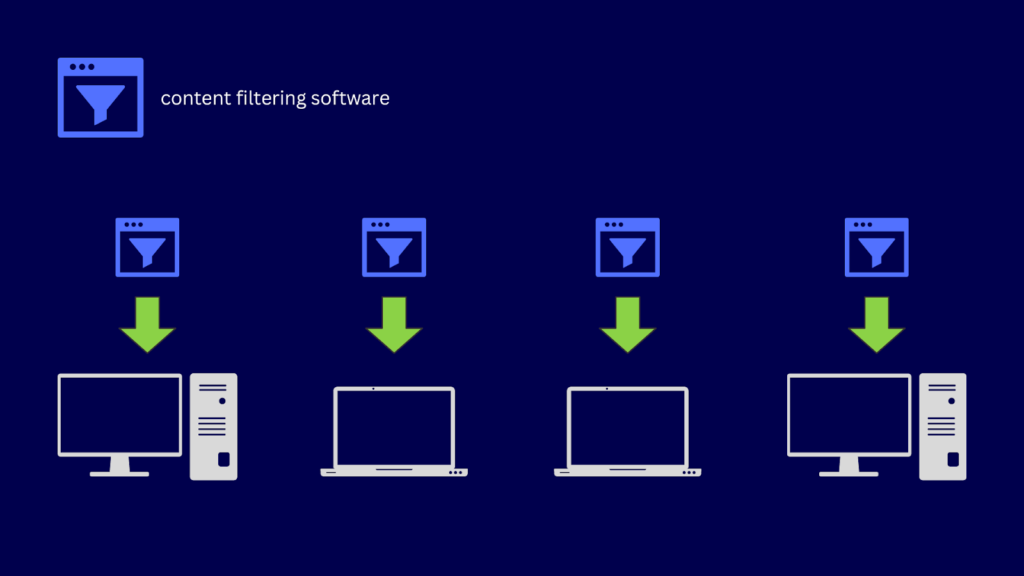
IMAGE SOURCE: Created using Canva
Moreover, while updating is simple, you must update client-based filters individually. So, if a user doesn’t do the update, that installation isn’t effective against new threats. To cut these oversights, ensure you remind users to update. If you only have a few users and devices, this software is the best for your business. Client-based content filters can be as effective as the other three filters. The main downside is its lack of scalability. This type of filter is best for SMBs with less than 10 users.
2. Server-Based
A server-based content filter has two components—a server and a firewall. The server contains the application’s database and management. However, the firewall is deployed along the network traffic’s path. It filters out unwanted packets for the entire network behind it. Unlike client-based filters, this content filter requires only one database update. You carry out administration and maintenance quickly and easily.
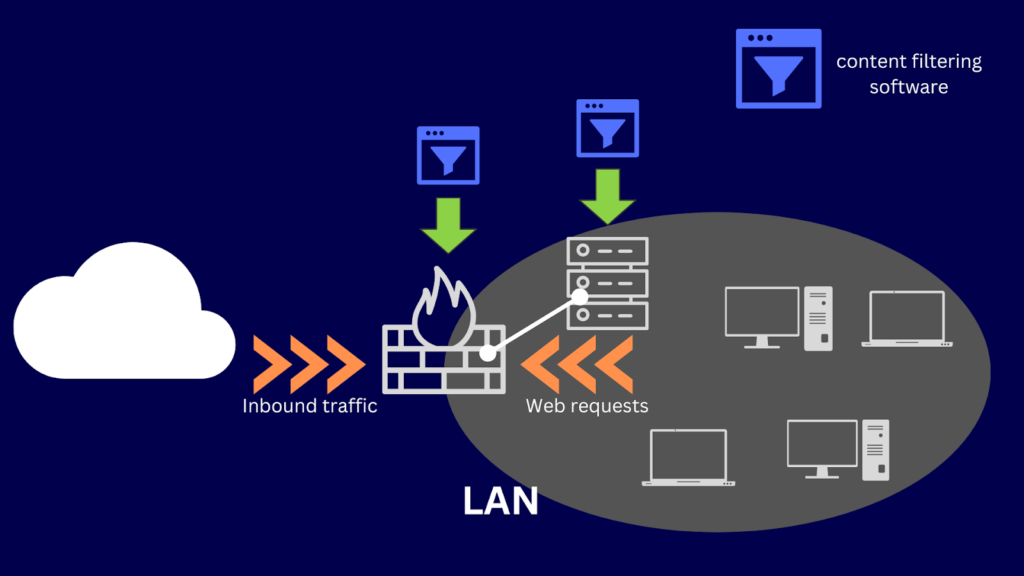
IMAGE SOURCE: Created using Canva
You must ensure the server has enough storage space to accommodate database updates. This filter is a perfect match if you have a bigger organization and meet those requirements. This filter type is typically too expensive for SMBs. It also requires more advanced IT skills for deployment and administration.
3. Gateway-Based
A gateway-based content filter is installed and configured on existing hardware. This filter is deployed in-line along the network traffic’s path. Most gateway-based filter vendors package the content filter application with a customized OS. You then deploy this package on your hardware. Gateway-based solutions only need to be updated and administered in one place.
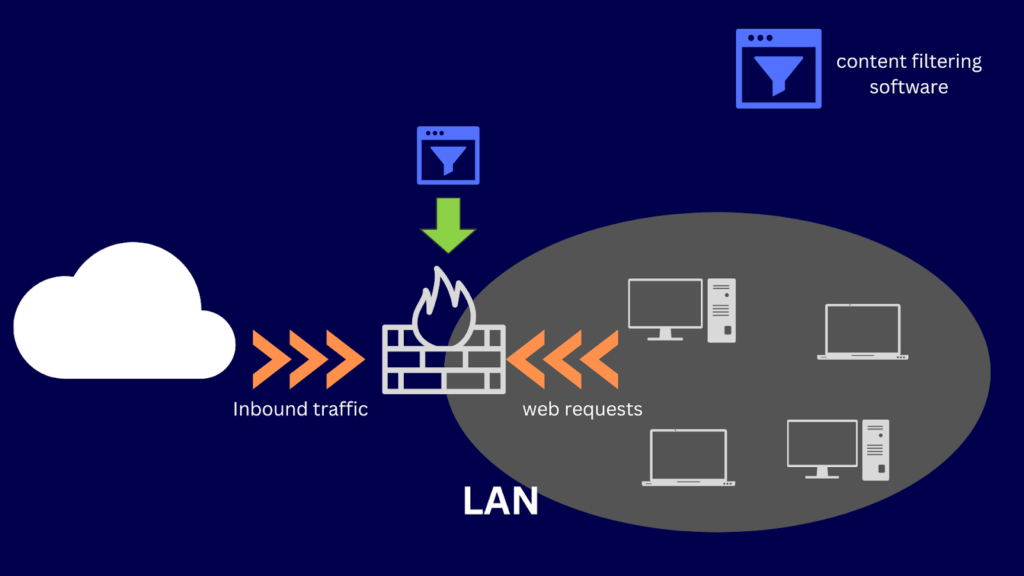
IMAGE SOURCE: Created using Canva
First, check that your underlying hardware has enough CPU and RAM to handle filtering and management processes. You must also ensure the hardware has enough storage space to accommodate database updates. You consolidate all components on a single device. Your financial and administrative requirements are lower than with server-based solutions. This filter is well-suited to medium and large businesses, and the choice between gateway and server filters depends on your architectural preference.
4. Cloud-Based
A cloud-based content filter is a security solution delivered as Software-as-a-Service (SaaS). A SaaS service provider deploys, manages, and updates all content filter components. All DNS requests and inbound emails are run through your provider. Then, the provider filters out harmful content. You don’t have to worry about upfront costs. Instead, you only pay on a subscription or consumption basis.
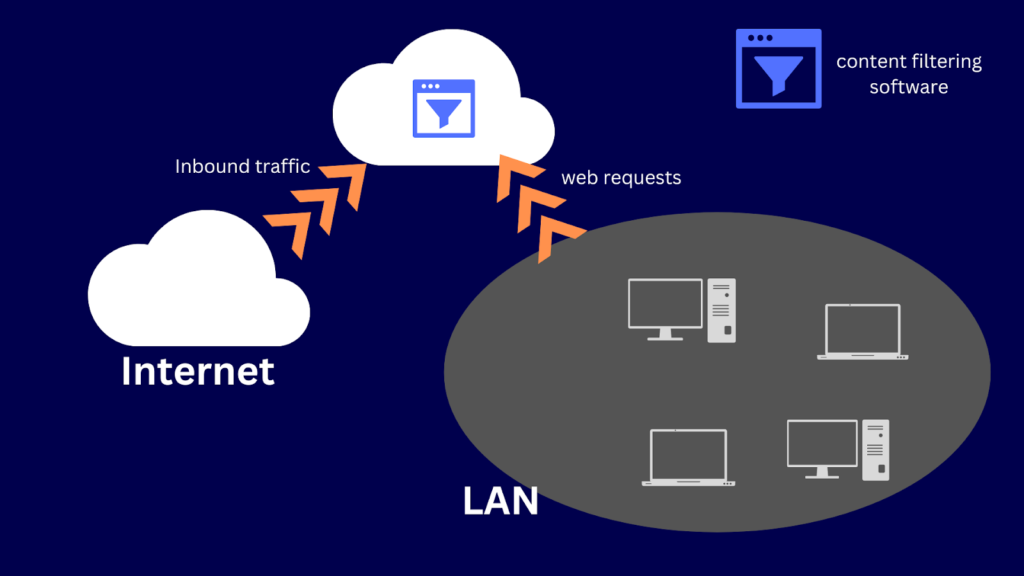
IMAGE SOURCE: Created using Canva
From a financial and operational standpoint, cloud-based content filters offer the greatest flexibility. It’s also the most scalable. Your service provider can easily meet any increase in demand. For medium-to-large businesses, cloud-based can be the best content filtering software option. However, the ongoing costs make this option the most expensive in the long run, especially for SMBs.
All four filter types are effective and equally capable of filtering undesirable content. But each architecture has characteristics that make it more suitable for certain businesses. You have to consider them from an administrative and economic standpoint. For example, client-based suits organizations with few devices. Cloud-based is ideal if you want zero upfront cost. Once you’ve identified the filter type that best matches your business, the next step is to find options. At this stage, we’ll shift our attention to key features.
| Client-Based | Server-Based | Gateway-Based | Cloud-Based | |
| Pros | Cheapest Effective Easy to update | Quick and simple Network-wide protection Only one database update | Cheaper Customized OS Uses existing hardware | Scalable Flexible Subscription/Consumption-based |
| Cons | Doesn’t scale well | Requires advanced IT skills | Must monitor CPU and RAM | Expensive |
| Best For | Small businesses (less than 10 users), beginners | Large businesses | Medium and large businesses | Medium and large businesses |
Top 6 Content Filter Features
Modern content filters have many features. Of course, some features are more important than others. The best content filtering software must have these 6 key features to ensure your business is adequately protected at all times.
1. Comprehensive and Updated Filtering
Malicious and harmful content is all over the internet. Content can be found on applications, websites, and cloud-based services. Your content filter should support multiple filtering capabilities to block various threats. At the very least, it should enable you to apply filtering rules on the objects mentioned.
Your content filter must also continuously update its applications, sites, and services list. A continuous update ensures that newly released content is always taken into account. Even the smallest SMB can be exposed to the latest malware through the sites their users’ visit. An updated content filter can mitigate that risk.
2. High Availability
Server and gateway-based content filters are deployed along the network traffic’s path. For this reason, content filter system failures can severely impact user connectivity. To maintain connectivity during a filter crash, you might be forced to deploy an ordinary router. This may expose your network to various threats, as an ordinary router doesn’t do any filtering.
A high availability (HA) feature minimizes downtimes even if a system crash occurs. This feature is essential to your SMB operations, as it prevents productivity loss without compromising security.
3. Administrative Flexibility Features
Every day, system administrators have plenty of work. More so with SMB admins, who wear multiple hats. Too much overload can lead to oversights and inefficiencies. It doesn’t help when a new IT solution is too unwieldy. Avoid overloading your admins by choosing a content filter equipped with flexibility features.
Flexibility comes in different forms. Deployment flexibility, for instance, offers many options for deployment. Your admins should be able to follow a deployment path that aligns with your current infrastructure. After deployment, your admins can access your filter’s admin interface anytime, anywhere. The idea is to look for features that enable admins to do tasks easily.
4. Actionable Reporting
Most content filter software options are configurable. For example, you can modify traffic-shaping rules to suit a particular use case, department, or schedule. But configurability is useless if you lack relevant data to inform your configuration decisions.
You should be able to extract information from log data. However, SMBs don’t normally have staff to analyze filter logs and translate the information gathered. Actionable reports can help in that regard. This is because actionable reports provide insightful information. Then, your admins can use this data to arrive at optimal content filter settings.
5. Service Quality
Content filters don’t have to crash to impact your network. For the same reason, I gave in feature 1, even a fully operational content filter can affect network performance. Your content filter software should have a Quality of Service (QoS) feature to minimize network degradations. In essence, QoS is characterized by mechanisms that allow network traffic priority.
SMBs usually have limited bandwidth. But they need to support multiple users, services, and applications. A QoS feature allows you to work around that limitation. With a QoS feature, you can prioritize mission-critical traffic. As you may have gathered above, a QoS feature works well with actionable reporting.
6. Works alongside Key Security Tools Like Firewalls and VPNs
Every internet-connected SMB is exposed to various cyber threats. Unfortunately, you can’t employ a one-size-fits-all solution for them. Your best bet is to take a multi-layered approach and combine many security tools. For instance, a server-based content filtering architecture integrates with a firewall. And there’s a great reason for this.
A firewall already has a filtering function. Integrating it with a content filter enhances that function. Then, rather than blocking only inbound packets, you can also block outbound requests. You can also use a firewall and content filter with a VPN. Doing so enables you to apply security at your network perimeter and on your connections with external parties. A content filter that works well with other security tools can help you implement a multi-layered cybersecurity strategy.
You’re now equipped with enough information to find the best content filtering software for your business. To help jumpstart your search, here are my top 5 recommendations.
Top 5 Content Filtering Software
These products come as hardware, virtual appliances, and cloud-based solutions. This article’s about software, so I’ll focus on virtual appliances and cloud offerings.
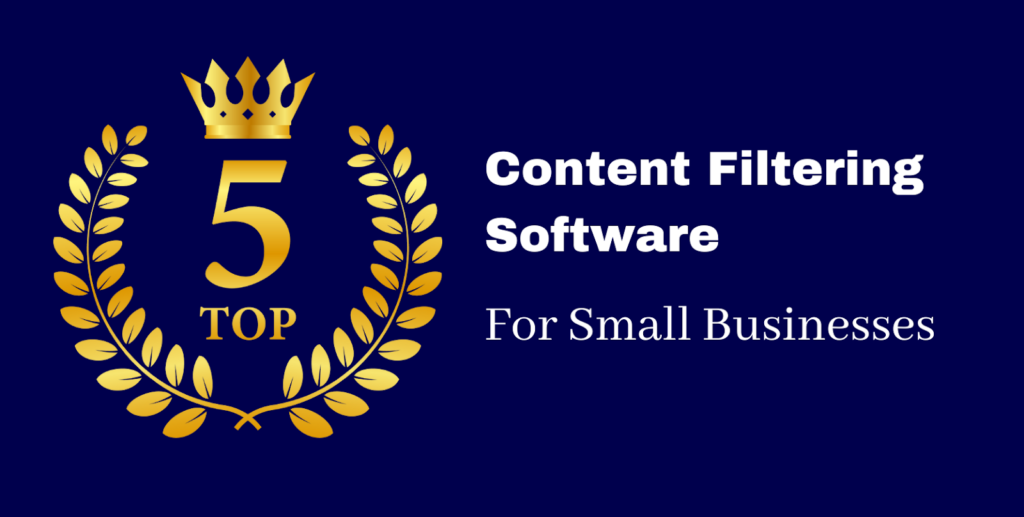
Image source: Created using Canva
1. Barracuda Web Security Gateway
Barracuda Web Security Gateway is a hardware and virtual appliance. It enables you to control user access to applications and websites. You can apply restrictions based on users, groups, time, and other factors. This web filtering tool protects your systems against spyware, malware, viruses, and known malicious sites.
Barracuda Web Security Gateway can support 100 to 35,000 concurrent users. Also, depending on the model, it supports network throughputs from 10 Mbps to 6,500 Mbps. As a bonus, you can apply configuration and management changes through a cloud-based portal. It also provides dashboard views, reporting, and alerts through that portal. Overall, Barracuda is well-suited to smaller and medium-sized businesses.
2. DNSFilter
DNSFilter is an AI-powered, cloud-based content filter. They have 15,000+ brands that use their service, including Lenovo, the US Army, and Nvidia. It relies on the Domain Name System (DNS) to do filtering. When a user sends a domain name request through a browser, that request is routed to DNSFilter’s servers. There, it’s checked against security policy settings and threat feeds. As a result, DNSFilter blocks all requests directed at known malicious sites.
DNSFilter has 35+ content categories, 7 threat categories, and several safe search options you can allow or block. Additionally, you’re protected against cryptojacking, malware, DNS poisoning, phishing, ransomware, zero-day threats, and DNS tunneling. All in all, this option would suit any business size thanks to its great pricing.
3. Cisco Umbrella
Cisco Umbrella is another AI-powered, cloud-based content filter solution. They’ve partnered with 1,000+ organizations, including Verizon, AT&T, and Microsoft. These partnerships allow Cisco to establish 6,000+ peering sessions, significantly reducing latency.
In a cloud-based architecture, packets still need to be routed through the service provider’s data centers. So, these peering partners give Cisco Umbrella a big boost in latency reduction. All Cisco Umbrella data centers are at least Tier 3 and maintain exceptional availability levels. Pricing is bespoke, so any business size can use Cisco Umbrella, and you can tailor it to your needs.
4. GFI KerioControl
GFI KerioControl is a comprehensive security solution purpose-built for SMBs. Aside from content filtering, KerioControl incorporates intrusion prevention system (IPS), firewall, and virtual private network (VPN) capabilities. It also comes with HA, QoS, and reporting features. Equipped with deployment flexibility, KerioControl has software, virtual machine, and hardware appliance options.
KerioControl’s web filter restricts access to 100+ continuously updated content and application categories. It’s an on-premises solution, so it doesn’t have latency issues like cloud-based solutions. KerioControl presents a strong case as the best content filtering software for SMBs.
5. FortiGuard Web Filtering Service
FortiGuard Web Filtering Service is another AI-powered, cloud-based filtering tool. Its web filtering database is updated about every five minutes. You can monitor these updates on FortiGuard’s website by clicking the link above. These frequent updates involve hundreds and thousands of enhanced, added, and removed URLs.
A constantly updated database is the most important content filtering tool feature. To date, FortiGuard has blocked over 66 million malicious, phishing, or spam URLs. While it’s more expensive, it offers great filtering protection. However, this makes it better suited to medium-sized and large businesses.
Here are some key takeaways from this section.
| Product | Type/Architecture | Key Differentiator |
| Barracuda Web Security Gateway | Gateway-based | Supports high throughput |
| DNSFilter | Cloud-based | Lowest base price |
| Cisco Umbrella | Cloud-based | Low latency for a cloud-based content filter |
| GFI KerioControl | Gateway-based | Excellent value for money |
| FortiGuard Web Filtering Service | Cloud-based | Frequent updates |
Alright, time to wrap things up.
The Bottom Line
I’ve gone over a systematic approach to choosing the best content filtering software for your business. It starts with knowing the different content filter types and what they do. Without this knowledge, you can’t make the correct decision for your business.
For SMBs, your budgetary and technical constraints are the biggest hurdle, so client-based and gateway-based options may be best. They’re cheaper and easy to operate. If you have a medium-sized business that is expanding, a server-based content filter may be more in-line with your needs.
As SMBs increase their internet-based resource consumption, their exposure to cyber threats grows. The best content filtering software creates a multi-layered defense that reduces cyber incident risks.
If you encountered any questions throughout this article, check out the FAQ and Resources sections below.
FAQ
Aside from using spam filters, what else can you do to secure user emails?
You can institute email security policies. Email security policies provide users with guardrails that limit user exposure to email-based threats. One important email security policy is prohibiting employees from using company email for personal communications.
Do firewalls already have content filtering functionality built-in?
No, not all do. Only advanced firewall types have content filtering built-in. Most Next Generation Firewalls (NGFWs) already have content filtering capabilities. Older types like packet-filtering firewalls, circuit-level gateways, and stateful inspection firewalls don’t have that capability yet.
What else can you do to improve your firewall’s effectiveness as a filtering tool?
One thing you can do is adopt the principle of least privilege. This principle involves restricting network access to users that require access to fulfill their duties. Start by denying all access by default and then gradually add access to those that need it for work. Our article on firewall best practices offers more insights on this topic.
How do I choose a firewall for my small business?
First, you need to understand a firewall’s main features. These features include packet filtering, stateful inspection, and router functionality. Next, you need to learn other features like deep packet inspection, DDoS protection, and web filtering. Why should you know all these? Find out in our article about choosing a firewall for small businesses.
What can happen once malware slips through your firewall/content filter?
Once malware gains initial access after slipping past your firewall/content filter, it’ll attempt lateral movement. Lateral movement is a cyberattack tactic involving navigating across your network to compromise more systems. This tactic enables threat actors to establish additional entry points should the initial compromise be uncovered.
Resources
TechGenix: Article on Email Spam Filters
Explore the reason’s why you would need an email spam filter for your business.
TechGenix: Guide on IPsec VPN
Find out everything you need to know about IPsec to secure your data.
TechGenix: Introductory Guide on IKEv2 VPN
Read about the basic concepts of IKEv2 and what it means for your business.
TechGenix: Introductory Guide on WireGuard VPN
Discover the various aspects of WireGuard and how it affects your remote work.
TechGenix: Introductory Guide on PPTP VPN
See why it’s time to stop using PPTP as a VPN protocol immediately.



